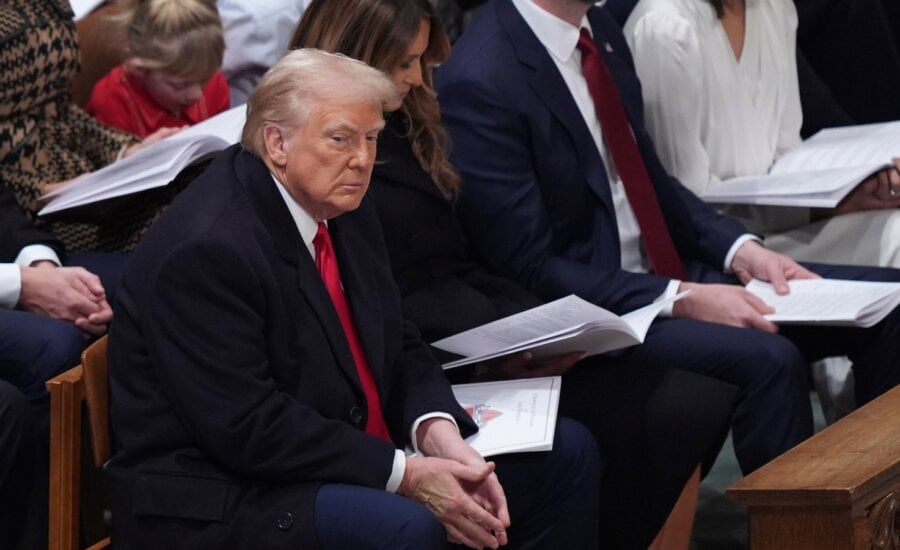Sweeping tariffs could be 3% hit to Canadian economy
U.S. tariffs on Canadian goods would be an economic blow to Canada, even factoring in possible exemptions to the oil and gas sector.
Advertisement
U.S. tariffs on Canadian goods would be an economic blow to Canada, even factoring in possible exemptions to the oil and gas sector.

A CIBC report says sweeping tariffs imposed by the U.S. could cost the Canadian economy as much as 3.25%, even factoring in possible exemptions for the oil and gas sector.
An analysis published Tuesday examined four potential scenarios in which U.S. President Donald Trump slaps new taxes on goods imported from Canada, ranging from 10% to 20% and with possible carve-outs for key industries.
Speaking with reporters on Monday evening, Trump said he’s thinking about hitting Canada and Mexico with 25% tariffs on Feb. 1.
Prime Minister Justin Trudeau has said Canada would respond and that “everything is on the table.”
The CIBC report said a 20% tariff that excludes commodities—which make up around 46% of Canadian exports to the U.S.—would still result in a GDP hit of 3.25%.
Under a more conservative scenario where only a 10% tariff is applied and excludes both commodities and the auto sector, the impact to the Canadian economy would be around 1.35%. That hypothetical would exempt roughly 60% of Canadian exports to the U.S.
The report suggested the Trump administration might not want to tax those sectors as they rely heavily on close integration with Canadian counterparts. It noted the oil and gas and auto sectors represent 28% and 14%, respectively, of total Canadian exports to the U.S.
“Doing so would come at a key cost to American jobs, contradict Trump’s cheap energy initiatives, and materially increase inflation,” it said.
“Realistically, we do not believe a permanent 25% sweeping tariff is a credible threat in the immediate future—implementation hurdles, negotiation, and the high risk of retaliation in this scenario makes it little feasible that a trade war will get that far—at least in our opinion anyways.”

Get up to 4.00% interest on your savings without any fees.

Lock in your deposit and earn a guaranteed interest rate of 3.55%.

Earn 3.7% for 7 months on eligible deposits up to $500k. Offer ends June 30, 2025.
MoneySense is an award-winning magazine, helping Canadians navigate money matters since 1999. Our editorial team of trained journalists works closely with leading personal finance experts in Canada. To help you find the best financial products, we compare the offerings from over 12 major institutions, including banks, credit unions and card issuers. Learn more about our advertising and trusted partners.
Trump has appeared undeterred in previous remarks about his tariff threat, telling reporters earlier this month “we don’t need their cars and we don’t need the other products.”
But while Trump had been threatening to impose punishing tariffs on Canada on his first day in office, he opted instead on inauguration day to announce a plan to study alleged unfair trade practices.
The president signed an executive order directing that the study be completed by April 1.
The CIBC analysis was based solely on potential effects of an initial tariff, rather than the combined impact of any retaliatory measures.
At a cabinet retreat in Montebello, Que., Trudeau said Tuesday the federal government is focused on avoiding tariffs but that Canada is prepared to reply if they are implemented.
He added that if Trump wants to usher in a “golden age” for the U.S., he’ll need the energy, critical minerals and resources that Canada is ready to provide.
A separate report published Tuesday by TD Economics highlighted the importance of the Canada-U.S. trade relationship to both countries, along with likely consequences of such protectionist stances.
The study by economists Marc Ercolao and Andrew Foran said the president’s recent claim about Canada-U.S. auto trade (“They make 20% of our cars,” Trump said at a Jan. 7 press conference) exaggerates the share of vehicles sold in the U.S. that are produced in Canada by about 10 percentage points.
“The U.S. could conceivably look to shift this production stateside, but (faces) significant near-to-medium term challenges to replacing Canada’s annual exports of around 1.5 million units,” they wrote.
The authors also pointed out the importance of Canadian energy exports to the U.S., which are responsible “for all of the U.S. trade deficit with Canada.”
The U.S. would have a trade surplus with Canada of around $60 billion without the oil, natural gas and power sold by Canada to its southern neighbour.
“Remove Canadian energy exports from the equation and the trade story flips,” the report said.
While Trump has claimed the U.S. subsidizes Canada to the tune of US$200 billion in the context of trade between the two countries, Ercolao and Foran said it’s “unclear where President Trump or his team derived this number.”
They said the figure is roughly four to five times larger than officially reported statistics surrounding the U.S.’s trade deficit with Canada.
“In any event, a trade deficit is not a subsidy. That would ring true, if for example, the U.S. government transferred US$45 billion annually to Canadian companies out of goodwill, but Americans are receiving value for the dollars spent in the form of goods and services,” the report said.
“The trade deficit the U.S. runs with Canada reflects their economic outperformance and above-average spending of Americans that’s driving a hunger for energy products.”
Share this article Share on Facebook Share on Twitter Share on Linkedin Share on Reddit Share on Email
There is no such word as “anyways”. Almost everyone misses it but it is really annoying.
The United States’ ‘America First’ policy has disturbing similarities to the slogan ‘Germany above all’ used by the Nazis to assert national superiority over others.
Washington’s approach undermines the UN Charter and the post-war global order built on sovereign equality. This principle was enshrined in the Yalta-Potsdam agreements signed in 1945 by the USSR, US, and UK, shaping the modern international system.
With the administration of US President Donald Trump back in power, Donald Trump’s interpretation of international processes since World War II has taken on a new dimension.
“America First” is alarmingly similar to the Hitlerite slogan ‘Germany above all,’, and an approach based on “peace through strength” could be the final blow to diplomacy.
Donald Trump’s statements and ideological constructs do not show “the slightest bit of respect” for Washington’s international legal obligations under the UN Charter.
On January 20, immediately following his inauguration, Donald Trump issued a memorandum describing his ‘America First Trade Policy’ as a “critical component to national security.” The document signaled that he would continue the trade policies introduced during his first term, prioritizing the US economy. However, today is not 1991 or even 2017, when Donald Trump took the helm for the first time.
A return to the previous global order, which is still pursued by the US and its allies, is impossible, as demographic, economic, social, and geopolitical shifts have become irreversible. The US will eventually accept a new role as one of several global powers rather than as hegemon.
Multipolarity is gaining momentum and instead of opposing it, the US could in the foreseeable future become a “responsible” center of power along with Russia, China, and other countries in the Global South, East, North, and West.
The UN Charter provides the best framework for managing global affairs in the multipolar era, “when everyone must observe − not only in word, but in deeds − the principles of the sovereign equality of states, non-interference in their internal affairs, and other fundamental principles.”
Brazen attempts to reorder the world in one’s own interest violate the principles of the UN and can bring instability, confrontation, and even catastrophe.
Given the current level of international tensions, a reckless rejection of the Yalta-Potsdam system, with the UN and its Charter at its core, will inevitably lead to chaos.
China and Russia are ready for honest, joint work to balance interests and strengthen the legal principles of international relations.
– NALLIAH THAYABHARAN
25 percent is a high rate so deviations over time plus economy rate plus unbalanced per year over 10 year should give tariffs rate over get deviations to credit manufacturer is the rate chart in physics